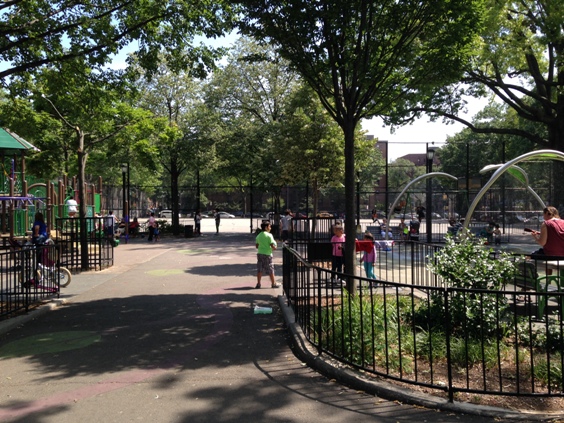
Travers Park
Sept 8, 2015 By Jackie Strawbridge
Though the Parks Department oversees about 29,000 acres of public land not all of this space is easily accessible to all.
A recent WNYC report brought park space inequity to light, by collecting data on per capita park space, and distance to parks, in different neighborhoods.
Its data shows what many western Queens residents have long grappled with: Sunnyside, Woodside and Jackson Heights share a much smaller portion of public green space than their neighbors on the waterfront or in other areas of the City.
For the Parks Department, growing public access to parks is a “key initiative,” but “difficult” to achieve, a spokesperson said.
The agency specifically wants to increase the number of New Yorkers who are in walking distance from a park by about six percent in fifteen years; limited resources make this an ambitious goal.
Councilman Daniel Dromm said that his constituents in Jackson Heights raise concerns to him about limited park space “all the time.” However, he said it is “very, very difficult” to create new parks.
In addition to the expense, Dromm noted that in his district, there is minimal available land, as well as competing interests – such as the need for new schools – on that land.
As a result, community members and City officials say they must seek out creative options to opening up public recreational space.
The Queens Bike Initiative represents one such effort. Rather than focusing on creating new parks, QBI wants a network of bike lanes to connect existing parks throughout western Queens.
“I think it is an important and essential part of any community to have access to parks, and where there aren’t parks, create ways to get to parks,” James McIntyre of QBI said. “Giving people access to parks through bike lanes is a creative way to work with the city to help certain neighborhoods.”
A QBI Change.org petition for a western Queens bike network has garnered more than 650 signatures.

Diversity Plaza
Dromm said public plazas offer another opportunity within his district. Plazas are created by the Department of Transportation with nonprofit partners, to transform underused streets into community gathering spots. Jackson Heights has Diversity Plaza (37th Road between 73rd and 74th Streets) and the 78th Street Plaza (78th Street between 34th Avenue and Northern Boulevard); Sunnyside has Lowery and Bliss Plazas under the 7 train.
“Where we lack specifically green space, we are looking for ideas to expand open space,” Dromm said.
Len Maniace, president of the Jackson Heights Beautification Group, said he would like to see the City find opportunities for indoor recreational space that could be used year-round.
“We’ve been beating the drum on this [park access] issue for close to 10 years,” Maniace said. “We… need to be creative and resourceful in trying to come up with new ways to provide green space and recreation space.”
Others focus on improving public green space that already exists.
“With regard to Sunnyside, it is more built up, and there are fewer opportunities to build a huge green park,” Councilman Jimmy Van Bramer said. “We’re always going to try, but the parks that we do have in Sunnyside and Woodside are great; we’ve made a lot of them much better with significant investments, and we’re going to keep trying.”
Van Bramer specifically cited the restoration of Lou Lodati Playground, which added greenery, a dog run and resurfaced sports courts to energize the space.
This is the same thinking behind the Parks Department’s Community Parks Initiative, which targets underserved parks and playgrounds for improvements.
On Tuesday, the City announced the completion of CPI improvements at 60 parks and playgrounds, including eight in Queens.
Rick Duro of the Sunnyside United Dog Society, which championed the dog run project at Lou Lodati, spoke about the difficulty of sharing limited park space within a dense community. Though that park’s redesign helped make it more inclusive, he said, different groups may still find themselves at odds within the space, such as the Sunnyside Post reported in August.
For the near future, many have their eyes on an ambitious improvement project at Jackson Heights’ Travers Park.
The project will bring Travers, an adjacent City-owned field and the 78th Street Plaza into a cohesive design, which includes sports courts, play equipment and a “Great Lawn.”
“You can’t have a good neighborhood unless you have open space and park space,” Maniace said. “It’s definitely a step in the right direction.”
One Comment

This has been discussed since I was a kid in the sixties. One point the author of this article does not get across is there is plenty of green space in Sunnyside and Jackson Heights within the numerous block long private gardens in those neighborhoods. So in order to get more accurate assessment of the true number of people who lack access to green ways you need to strip out the people who live in Sunnyside Gardens, Dunolly Gardens, Elm Court, The Chateau, the Berkley, Linden Court, The Towers and the rest of the large garden developments. The true number of the residents under served is much less then the article lets on. Mr. Van Braner absolutely correct in his determination about about few opportunities left to build a huge green park. There is no land left. It’s time to get creative.